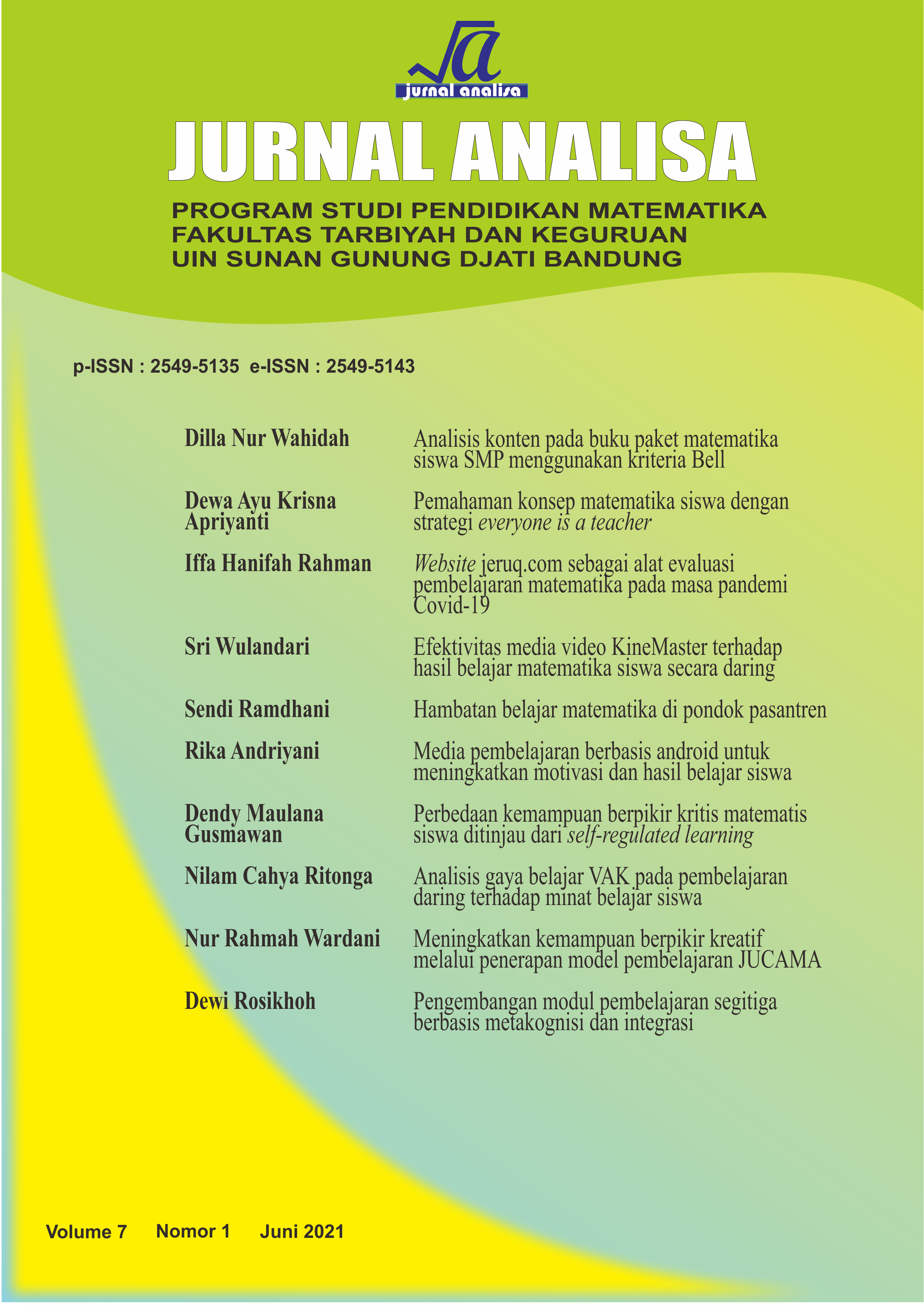Analisis konten pada buku paket matematika siswa SMP menggunakan kriteria bell
DOI:
https://doi.org/10.15575/ja.v7i1.10811Keywords:
Analisis Buku Paket Matematika, Kurikulum 2013, Konten dan Kriteria BellAbstract
Tujuan penelitian ini untuk mengetahui hasil analisis konten pada buku paket matematika siswa edisi Kurikulum 2013 Revisi 2016 terbitan Kemendikbud dengan menggunakan kriteria Bell. Â Metode penelitian ini adalah deskriptif kualitatif dengan subjek penelitiannya adalah buku paket matematika siswa SMP edisi Kurikulum 2013 Revisi 2016 terbitan Kemendikbud. Instrumen penelitian berupa lembar analisis kesesuaian buku. Pengambilan data berdasarkan hasil analisis yang dilakukan peneliti terhadap buku paket matematika siswa Sekolah Menengah Pertama edisi Kurikulum 2013 Revisi 2016 terbitan Kemendikbud berdasarkan konten kriteria Bell. Berdasarkan analisisnya, kesesuaian buku paket matematika terbitan Kemendikbud dilihat dari konten kriteria Bell mencapai 74, 29% yang termasuk pada kategori baik.
Kata kunci: Analisis, Konten dan Kriteria Bell.
The purpose of this study was to find out the results of content analysis in students' mathematics textbooks in the 2013 Revised 2016 Curriculum edition published by the Ministry of Education and Culture using the Bell criteria. This research method is descriptive qualitative with the research subject is the mathematics textbook for junior high school students in the 2013 Revised 2016 Curriculum edition published by the Ministry of Education and Culture. The research instrument was in the form of a book suitability analysis sheet. Data collection was based on the results of an analysis conducted by researchers on the mathematics textbooks for junior high school students in the 2013 Revised 2016 Curriculum edition published by the Ministry of Education and Culture based on the content of Bell's criteria. Based on his analysis, seen from the content of Bell's criteria reached 74.29% which was included in the good category.
Keywords: Analysis, Content and Bell’s Criteria.
References
Arikunto, Prof. Dr. S. (2013). Manajemen Penelitian. Rineka Cipta.
Azizah, R. (2015). Analisis Buku Teks Matematika Kurikulum 2013 Penerbit Kementerian Pendidikan dan Kebudayaan untuk SMA Kelas XI Pokok Bahasan Statistika Berdasarkan Kriteria Bell.
Bell, F. H. (1978). Teaching and Learning Mathematics (In Secondary Schools). Wm. C. Brown Company Publisher.
Beni, I. G., Trapsilasiwi, D., & Kristiani, A. I. (2013). Analisis Buku Matematics for Junior High School Grade VIII 1 st Semester (Bilingual) Berdasarkan Kriteria Bell. KadikmA, 4(2).
Fajriatin, A. (2017). Analisis Buku Matematika Kelas IX Kurikulum 2013 Berdasarkan Kesesuaiannya Dengan Materi Matematika Menurut Kriteria Bell dan Pendekatan Saintifik. PROSIDING, 67.
Haustin, Z. H. (2014). Analisis Buku Matematika SMP/MTs Kelas VII Semester I Kurikulum 2013 Berdasarkan Kriteria Bell.
Ikhwandi, I., Dafik, D., & Suciati, S. (2015). Telaah Kesesuaian Buku Guru Matematika Kelas X Kurikulum 2013 Berdasarkan Pendekatan Saintifik. Pancaran Pendidikan, 4(1), 117–128.
KBBI, K. B. B. I. (2014). Kamus Bahasa Indonesia Edisi Terbaru. Pandom Media Nusantara.
Lestari, Y. P. (2011). Ensiklopedia Matematika (A - J). PT INDAHJAYA Adipratama.
Ramda, A. H. (2017). Analisis kesesuaian materi buku teks Kemendikbud matematika kelas VII dengan Kurikulum 2013. Pythagoras: Jurnal Pendidikan Matematika, 12(1), 12–22.
Shield, M., & Dole, S. (2013). Assessing the potential of mathematics textbooks to promote deep learning. Educational Studies in Mathematics, 82(2), 183–199.
Wardhani, S. (2010). Implikasi karakteristik matematika dalam pencapaian tujuan mata pelajaran matematika di SMP/MTs. Departemen Pendidikan Nasional Direktorat Jenderal Peningkatan Mutu Pendidik Dan Tenaga Kependidikan Pusat Pengembangan Dan Pemberdayaan Pendidik Dan Tenaga Kependidikan (PPPPTK) Matematika.
Downloads
Published
Issue
Section
License
Authors who publish in Jurnal Analisa agree to the following terms:
1. Authors retain copyright and grant the journal right of first publication with the work simultaneously licensed under a Attribution-ShareAlike 4.0 International (CC BY-SA 4.0) License that allows others to share the work with an acknowledgment of the work's authorship and initial publication in this journal.
2. Authors are able to enter into separate, additional contractual arrangements for the non-exclusive distribution of the journal's published version of the work (e.g., post it to an institutional repository or publish it in a book), with an acknowledgment of its initial publication in this journal.
3.Authors are permitted and encouraged to post their work online (e.g., in institutional repositories or on their website) prior to and during the submission process, as it can lead to productive exchanges, as well as earlier and greater citation of published work (See The Effect of Open Access).


